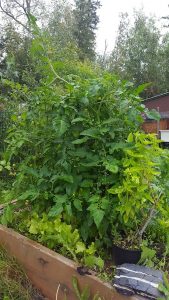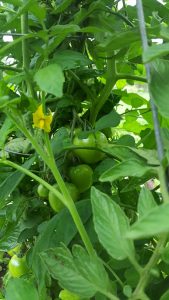Climate change is no joke, and I am certainly no expert on the subject. Many of us have read various reports, observations, and predictions about the consequences of a changing climate on Alaska and Alaskans’ ways of life. This post is not intended to be a debate or manifesto on climate change, but one component of this year’s garden did get me thinking particularly deeply about the Alaska climate and weather and gardening. That component was the gift of two tomato plants and the fact that I do not have a greenhouse.
What is the connection between climate change, tomatoes and Alaska?
As we all know, pretty much everyone recommends growing tomatoes in a greenhouse in Alaska. Yields will be greater, the fruit sweeter, the season longer. As a general guide, tomatoes will not set fruit if nighttime temperatures are below 55°F, and optimally the minimum temperature should not sink below 60°F. Daytime temperatures would ideally hover in the 70s or low 80s (°F).

I considered giving my newly gifted plants away or declining the offer to accept them. I was, however, fairly certain that they would not find another home and would wither away in their current home. I felt that I could at least give them a fighting chance; the rest would be up to Mother Nature and the type of weather we would receive in Palmer this summer.
Greenhouse-free tomatoes in Alaska
While it is generally not recommended to grow tomatoes here without some sort of season-extending structure, there are a few more rugged hybrids and heirlooms that are known to set fruit with colder night temperatures. A few hybrids such as Early Girl, Oregon Spring, and Golden Nugget along with heirlooms Glacier, Grushovka, Manitoba and Polar Baby have been recommended for Alaska gardens. Your outdoor tomatoes have a better chance either in a raised bed, a black container, or against a structure–anything that will retain heat and help raise soil temperature. Mine are in a raised bed, in full sun.
And what about climate change?
Climate forecasters predict that average temperatures in southcentral Alaska will rise by approximately one degree per decade. Precipitation will also increase, but it is expected that in this region, the increase in rain will be offset by an increase in evapotranspiration (water evaporating into the air from the ground and by transpiration from plants) due to our longer growing season and warmer weather. Overall, our area may actually see more drought than in the recent past.
Average temperature data for Anchorage shows that for the months of June, July and August, average lows are on the bottom end for tomato fruit to set. It would not take much to push us above a threshold for more consistent fruit setting if nights stayed slightly warmer. Our average high temperatures are also on the low end for ideal tomato growing conditions. A slight increase in average high temperatures could also increase yields and lengthen the growing season.
I probably chose a good year (knock on wood!) to try my outdoor tomato growing experiment. It has been a warm, sunny summer in Palmer. Statewide, numerous record high temperatures have been recorded from May through July, including a heat wave in Anchorage and multiple consecutive days above 70 °F during the prime growing time of mid-July. My two plants look gorgeous, especially because a “heat wave” in Anchorage still doesn’t exceed ideal high temperatures for tomato growing!

I should not speak too soon, however, because I haven’t seen a red hue as of yet on any of the fruit. As I write, we have recently experienced approximately 10 days of cooler, cloudier, wetter weather and while some of my garden plants are thriving with some relief from the blazing sun, my tomatoes seem to have settled into a holding pattern of unripened fruit. I am curious as to how the rainier month of August will affect productivity and I anticipate having a large number of green tomatoes to either ripen indoors or use in all their green glory. They make a great salsa or relish, here are a number of great recipe ideas.
My intent is not to make light of climate change and its effects on Alaska and Alaskans. Scientists predict many changes to our beautiful state; the beginnings of many of these changes have already been observed. They will undoubtedly have lasting impacts on all of us, but likely most notably on Alaskans whose lives and livelihoods are most closely connected with the ecosystems and natural environments in which they live. Some farmers and gardeners are anticipating these changes and working to adapt by using the changing environment as an opportunity to produce new or different foods in their communities. Undoubtedly it will be our ability to adapt and find creative solutions in order to thrive in our ever-changing landscape. Greenhouse-free tomatoes may or may not be a part of that, but they sure do get the mental juices flowing! I would love to hear your thoughts on adapting food production strategies in Alaska to a changing climate.